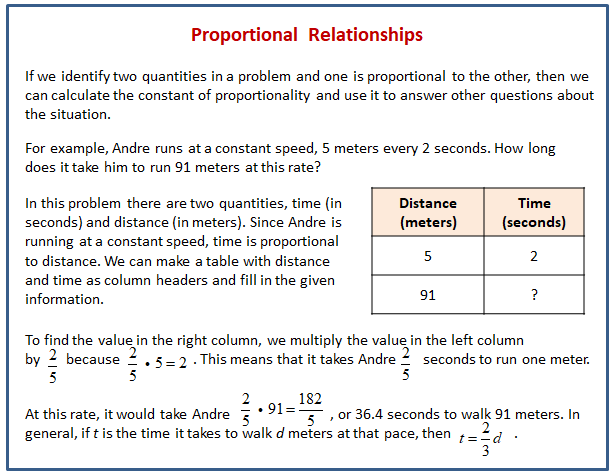Illustrative Mathematics Grade 7, Unit 4, Lesson 3: Revisiting Proportional Relationships
Learning Targets:
- I can use a table with 2 rows and 2 columns to find an unknown value in a proportional relationship.
- When there is a constant rate, I can identify the two quantities that are in a proportional relationship.
Related Pages
Illustrative Math
Grade 7
Lesson 3: Revisiting Proportional Relationships
Let’s use constants of proportionality to solve more problems.
Illustrative Math Unit 7.4, Lesson 3 (printable worksheets)
Lesson 3 Summary
The following diagram shows how to use constants of proportionality to solve more problems.

Lesson 3.1 Recipe Ratios
A recipe calls for 1/2 cup sugar and 1 cup flour. Complete the table to show how much sugar and flour to use in different numbers of batches of the recipe.
Lesson 3.2 The Price of Rope
Two students are solving the same problem: At a hardware store, they can cut a length of rope off of a big roll, so you can buy any length you like. The cost for 6 feet of rope is $7.50. How much would you pay for 50 feet of rope, at this rate?
- Kiran knows he can solve the problem this way.
What would be Kiran’s answer? - Kiran wants to know if there is a more efficient way of solving the problem. Priya says she can solve the problem with only 2 rows in the table.
What do you think Priya’s method is?
Lesson 3.3 Swimming, Manufacturing, and Painting
- Tyler swims at a constant speed, 5 meters every 4 seconds. How long does it take him to swim 114 meters?
- A factory produces 3 bottles of sparkling water for every 8 bottles of plain water. How many bottles of sparkling water does the company produce when it produces 600 bottles of plain water?
- A certain shade of light blue paint is made by mixing 1 1/2 quarts of blue paint with 5 quarts of white paint. How much white paint would you need to mix with 4 quarts of blue paint?
- For each of the previous three situations, write an equation to represent the proportional relationship.
Are you ready for more?
Different nerve signals travel at different speeds.
Pressure and touch signals travel about 250 feet per second.
Dull pain signals travel about 2 feet per second.
- How long does it take you to feel an ant crawling on your foot?
- How much longer does it take to feel a dull ache in your foot?
Lesson 3.4 Finishing the Race and More Orange Juice
- Lin runs 2 3/4 miles in 2/5 of an hour. Tyler runs 8 2/3 miles in 4/3 of an hour. How long does it take each of them to run 10 miles at that rate?
- Priya mixes 2 1/2 cups of water with 1/3 cup of orange juice concentrate. Diego mixes 1 2/ cups of water with 1/4 cup orange juice concentrate. How much concentrate should each of them mix with 100 cups of water to make juice that tastes the same as their original recipe? Explain or show your reasoning.
Lesson 3 Practice Problems
- It takes an ant farm 3 days to consume 1/2 of an apple. At that rate, in how many days will the ant farm consume 3 apples?
- To make a shade of paint called jasper green, mix 4 quarts of green paint with 2/3 cups of black paint. How much green paint should be mixed with 4 cups of black paint to make jasper green?
- An airplane is flying from New York City to Los Angeles. The distance it travels in miles, d, is related to the time in seconds, t, by the equation d = 0.15t.
a. How fast is it flying? Be sure to include the units.
b. How far will it travel in 30 seconds?
c. How long will it take to go 12.75 miles? - A grocer can buy strawberries for $1.38 per pound.
a. Write an equation relating , the cost, and , the pounds of strawberries.
b. A strawberry order costs $241.50. How many pounds did the grocer order? - Crater Lake in Oregon is shaped like a circle with a diameter of about 5.5 miles.
a. How far is it around the perimeter of Crater Lake?
b. What is the area of the surface of Crater Lake? - A 50-centimeter piece of wire in bent into a circle. What is the area of this circle?
- Suppose Quadrilaterals A and B are both squares. Are A and B necessarily scale copies of one another? Explain.
The Open Up Resources math curriculum is free to download from the Open Up Resources website and is also available from Illustrative Mathematics.
Try the free Mathway calculator and
problem solver below to practice various math topics. Try the given examples, or type in your own
problem and check your answer with the step-by-step explanations.

We welcome your feedback, comments and questions about this site or page. Please submit your feedback or enquiries via our Feedback page.